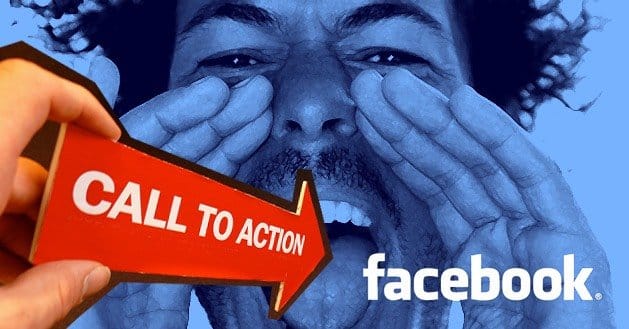 Written by ContentPowered.com
Written by ContentPowered.com
When it comes time to excite your Facebook users and direct them to your conversion landing page, what do you say? Do you tell them to BUY NOW? Do you tell them to submit their information? Do you ask them to click here… to a page you don’t specify? There are dozens of ways to write a call to action, and most of them suck. You don’t want yours to end up on that list, so try making use of these tips.
1. Understand the Situation
Before you can create a compelling call to action, you need to understand what you’re providing to your fans. A great call to action is perfectly tailored to suit both your business and your audience.
Consider a few questions. What is your niche and your area of expertise? What is the product or service you’re trying to sell? What value will a user get out of converting? What problem do you solve for them? What makes your business different from your competitors?
Another big question is what, exactly, your target action is. A call to action can be as simple as encouraging users to sign up for your email list, or it can be as complex as asking them to buy your product. Treat them equally; the less effort you put into your call to action, the more obvious and ignored it will be.
2. Keep it Clear and Easy to Understand
This doesn’t mean to opt with the super basic language like the “click here” or “buy now” examples above. Instead, it just means to use plain language. Some things to avoid:
- Industry jargon the common user won’t know.
- Acronyms without explanations to accompany them.
- References to ongoing discussions your users might not have seen.
- References to anything obscure enough your users won’t know what you mean.
- Corporate speak, dry statistics or anything that could be deemed boring.
The goal here is to make your call to action as compelling and understandable as possible to as many people as possible.
Make sure to extend this simplicity to any graphics you include in your call to action. If you’re posting something needlessly confusing in an attempt to delude people into thinking it’s artistic, you’re probably going to annoy some users and go over the head of others.
3. Ask a Question
When creating your Facebook post, start off with a question. It’s easy enough to create a question relevant to what you’re sharing. For example, if I were trying to share this post on Facebook and get you to click through, I might start my post with “Trying to create the perfect Facebook call to action?” Note that call to action is spelled out, rather than using CTA, even though many of the people who might see the post would know what it stands for. Even one user not knowing is one failure on the part of the call to action.
When the goal of your call to action is more abstract, you may have a harder time coming up with a compelling question. You may need to appeal to a user’s sense of curiosity to get them to keep up with your mailing list, for example. Obviously, you wouldn’t want to just ask them “Want more messages in your inbox?”
4. Tease Information
The second sentence of your post for a call to action should include some snippet of information from the target, if possible. Again, taking this article as an example. Starting with “Trying to create the perfect Facebook call to action?” I might continue “Here’s a tip; always ask a question.” While it spoils one of the tips in the article, it’s an immediate bit of value.
If your destination is an article, never give away everything of value in your post. If your post can be summed up in a single line, it’s probably thin content and won’t appeal to your users. Make sure your users know there’s more of value beyond that one tip; follow it up with something like “Read this piece for more call to action tips.”
5. Link Properly
On Facebook, you have three ways to post a link.
- A plaintext link. This is just directly copying and pasting the URL of your destination page. It’s generally long, bulky and truncated by the display limits on Facebook posts. If your URL includes tracking code – which it should – it’s obvious here.
- A shortened link. Using a service like Bitly allows you to create a custom shortened URL to hide the length and tracing parameters for your link. It’s a much better option if you absolutely need the text link present in your post.
- The preview window. When you paste a link into the submit box, Facebook generates a preview. You can then delete the actual URL from the text box and the preview will remain. This is the most elegant solution, as it doesn’t clutter up or truncate your URL.
Always include a link, unless your call to action is a direct Facebook metric, like sharing a particular post.
6. Maintain a Positive Attitude
Users don’t like clicking through to negative news, unless it is of the utmost importance that they see it. They likewise don’t like being told the content they might click through to see is not of the highest quality. Your goal here is to inspire feelings of confidence, inspiration, excitement and energy. Make the user feel as though with your advice they can truly succeed, and easily too, despite any previous setbacks.
This is hard to convey in a few short sentences, so don’t worry too much about it. The key is to remain within the positive spectrum of emotions rather than the negative.
7. Keep it Short, but Don’t Sacrifice Quality
Facebook does not have a hard character limit like Twitter does, but it does have something of a “soft” character limit. That is, after your post reaches a certain length, some of it will be hidden behind a “read more” link that users have to click to expand the comment. Essentially, only the first couple sentences of your post are guaranteed visible; anything beyond may be truncated away.
You don’t necessarily need to worry about individual characters. If you’re putting too much time into choosing the exact words to keep your post under the length for truncation, you’re probably wasting time. Don’t worry if your post goes over and the last few words are cut off. The important parts are the introductory question and the link preview.
8. Use Visual Media
Visuals attract the eye. Relevant visuals – that is, not something boring like your logo – are even better. Your goal here is to draw users in to read your link preview, then back up to read your post, which makes them read the call to action and presumably encourages them to click through. It’s all somewhat automatic; just include an image and human nature does the rest.
It’s important here to take advantage of the space Facebook gives you for images. Make sure they aren’t shaped oddly and that they preview looks good. If your image is squished, stretched or cropped poorly, users won’t click through to see what the article is about. Images even help if your CTA is centered around Facebook; a post with a picture is more easily shared, after all.



